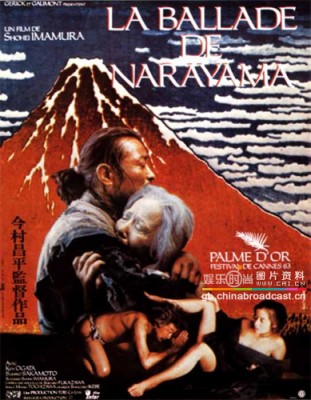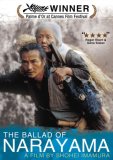| Reviews & Columns |
|
Reviews DVD TV on DVD Blu-ray 4K UHD International DVDs In Theaters Reviews by Studio Video Games Features Collector Series DVDs Easter Egg Database Interviews DVD Talk Radio Feature Articles Columns Anime Talk DVD Savant Horror DVDs The M.O.D. Squad Art House HD Talk Silent DVD
|
DVD Talk Forum |
|
|
| Resources |
|
DVD Price Search Customer Service #'s RCE Info Links |
|
Columns
|
|
|
Ballad of Narayama (1983), The
Though one might reasonably have expected this Palme d'Or-winner to turn up on Criterion's slate, it is instead an AnimEigo release. Imamura, who died in 2006 at 79, probably would have been amused that, given the label's reputation, AnimEigo likely was attracted less by the film's standing than by extensive nudity and grimly comic violence.* The transfer overall is okay, but glitch-prone Animeigo still manages yet another authoring flaw; it's fairly minor but will likely drive some to distraction. More on this below.
Set roughly in the early 19th century in rural, northern Japan, The Ballad of Narayama deals with the tradition of ubasuteyama, in which (usually) elderly parents are carried into the mountains by the children and left there to die of starvation or exposure, so that the younger and stronger generations have a better chance to survive feudal Japan's frequent bouts of drought, famine, and particularly harsh winters. (Not only did it really happen, cases of ubasuteyama were still being reported in Japan's poorest rural areas even after World War II.) The film establishes this reality right off, in a series of aerial shots over the mountainous, snow-covered, and unforgiving terrain. It takes place over one year, cyclically ending with the snow and the mountains also. The winter becomes then both a symbol of death and of a new beginning.
The story concerns one such village where the elderly are carried off to their doom upon reaching the age of 70. Matriarch Orin (Sumiko Sakamoto) is 69 when the story begins and in exceptionally good health. But she's already resigned to her fate, even eager to see it carried out. Partly this is because the pilgrimage has a religious significance, a chance to meet the Mountain God and be reunited with lost loved ones. There's also the matter of family pride; her willingness to face death with courage and honor will benefit her family's standing in the village. However, Orin's middle-aged eldest son, Tatsuhei (Ken Ogata) is a long way from being reconciled to the inevitable.
The film is of the type common to Japanese filmmakers of Imamura's generation, those that as teenagers endured the unimaginable hardships of decimated wartime Japan and its difficult aftermath. In very different types of movies, directors like Imamura, Kinji Fukasaku, Kihachi Okamoto and others expressed situations so casually cruel that they become grimly, perversely funny. Such an approach is almost clichéd in 2008, done to death as it has by a younger generation of insulated middle-class filmmakers from the suburbs who have adopted these techniques not as a personal reflection of anything but rather for its perceived hipness.
In Imamura's hands, however, The Ballad of Narayama resonates with numbing authenticity. It's a difficult film to watch at times; in practically the opening scene the corpse of a newborn baby, bloated and purplish, is found in a rice paddy and soon dismissed as fertilizer. It's a world of yakko, maltreated sons not allowed to marry (to curb over-population), where families - including pregnant women - caught stealing food are dragged from their homes and buried alive.
And yet, The Ballad of Narayama is crammed with the kind of humorous, taboo-busting sexual explicitness common to most of Imamura's films: here you'll find grotesque bestiality, even an explicit sex scene and nudity with septuagenarian Nijiko Kiyokawa. Almost overdone, Imamura equates the villagers to other wild creatures with myriad cutaways to animals copulating like their human counterparts and eating one another in varied combinations. (Snakes eating rats and vice versa, a praying mantis nibbling on a frog.) In the remote mountains where all the elderly are left to die one sees hundreds, perhaps thousands of skeletons; it's almost like the fabled elephant graveyard of the early MGM Tarzan movies.
Similarly, at times you're not sure whether to laugh or cry at the absurdities of such an existence. So healthy is Orin she worries her family won't be ready to give her up when she reaches 70, so in one painful scene she bashes her face into some stoneware, almost gleefully knocking out several teeth.
Those unfamiliar with actress Sumiko Sakamoto (The Pornographers) will be surprised to learn that she was only in her mid-forties when she played Orin - less than a year older than star Ken Ogata - and yet totally convincing as an old woman. She shares several scenes with actress Kiyokawa, who really was 70 at the time, yet they seem contemporaries. (The great Kinuyo Tanaka, also in her forties at the time, played Orin in Kinoshita's film.)
Imamura's ethereal direction is frequently mesmerizing, particularly the final half-hour tracing Tatsuhei and Orin's long odyssey up the mountain, told almost entirely visually with minimal dialogue. Its many awards are deserved.
From a production standpoint, The Ballad of Narayama is nearly flawless. The gorgeous, terrifying locations are superbly photographed by Masao Tochizawa, for instance. Only Shinichiro Ikebe's score, at one point incongruously incorporating an electric guitar (!) disappoints.
Video & Audio
The Ballad of Narayama is presented in 1.78:1 enhanced widescreen (not 1.85:1, as listed on the packaging) on a DVD-9 in dual-layered format. The image is generally clean with good color. However, there is a strange flaw intermittently whereby fluid motion is interrupted by what seems like repeated frames. It was noticeable to me about once per minute; some viewers might not notice it at all while others may find it much more distracting than I did.
The mono Japanese audio is notably clear and AnimEigo offers its usual option of full and limited English subtitles, the former inundating the viewer with annotations regarding cultural or language subtleties normally lost on most Western viewers.
Extra Features
Included are a series of trailers for both this and other AnimEigo releases. Also included are the label's standard program notes and a fairly extensive photo gallery.
Parting Thoughts
Though I prefer Imamura's early films to his middle and later period The Ballad of Narayama undeniably is hypnotic if difficult to watch and digest. It's an excellent film and milestone both in terms of Imamura's career and in Japanese cinema as a whole. Highly Recommended.
* I once tried to interest the label into sublicensing a Toshiro Mifune TV show I owned home video rights on. Once I had them on the phone their very first question to me about the show was - I'm not kidding - "Are there a lot of, you know, people getting their arms chopped off and blood and stuff?"
Film historian Stuart Galbraith IV's latest book, The Toho Studios Story, is on sale now.
|
| Popular Reviews |
| Sponsored Links |
|
|
| Sponsored Links |
|
|
| Release List | Reviews | Shop | Newsletter | Forum | DVD Giveaways | Blu-Ray | Advertise |
|
Copyright 2024 DVDTalk.com All Rights Reserved. Legal Info, Privacy Policy, Terms of Use,
Manage Preferences,
Your Privacy Choices | |||||||
















